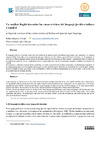Identificador persistente para citar o vincular este elemento:
https://accedacris.ulpgc.es/jspui/handle/10553/77387
| Título: | Análisis lingüístico sobre las características del lenguaje jurídico italiano y español | Otros títulos: | A linguistic analysis of the characteristics of Italian and Spanish legal language | Autores/as: | González Vallejo, Rubén | Clasificación UNESCO: | 590602 Lenguajes 5701 Lingüística aplicada |
Palabras clave: | Derecho Lenguaje jurídico Lenguaje de especialidad Morfología Extranjerismos, et al. |
Fecha de publicación: | 2020 | Publicación seriada: | LFE. Revista de Lenguas para Fines Específicos | Resumen: | El lenguaje jurídico se concibe como una subvariedad de la lengua común caracterizada por rasgos muy concretos y se muestra como el reflejo inmutable de los comportamientos que subyacen en cada cultura y que la diferencian de otras. A tal propósito, el presente artículo recoge las particularidades del lenguaje jurídico italiano y español con el fin de otorgar un breve decálogo de los aspectos más representativos para tener en cuenta en su traducción a través de numerosos ejemplos extraídos de la legislación vigente.
Inicialmente se abordará el plano léxico-semántico, en donde la presencia de palabras extranjeras y la fraseología acapararán el principal protagonismo; el nivel morfosintáctico, por su parte, prestará especial atención a la nominalización y a los tiempos verbales usados en ambos idiomas; por último, el nivel ortográfico y estilo se centrará principalmente en el uso de siglas y abreviaturas y en el oscurantismo del lenguaje jurídico. Legal language is conceived as a sub-variety of the common language characterized by very specific features and is shown to be the immutable reflection of the behaviors that underlie each culture and differentiate it from others. In this regard, this article brings together the particularities of Italian and Spanish legal language in order to provide a brief decalogue of the most representative aspects to be taken into account in its translation through numerous examples drawn from current legislation. Initially, the lexical-semantic level will be dealt with, where the presence of foreign words and phraseology will take the main role; the morphosyntactic level, on the other hand, will pay special attention to the nominalization and the verbal tenses used in both languages; and finally, the orthographic and style level will focus mainly on the use of acronyms and abbreviations and on the obscurantism of legal language. |
URI: | https://accedacris.ulpgc.es/handle/10553/77387 | ISSN: | 2340-8561 | Fuente: | LFE. Revista de lenguas para fines específicos [eISSN 2340-8561], v. 26 (2), p. 58-71 |
| Colección: | Artículos |
Visitas
83
actualizado el 07-sep-2024
Descargas
74
actualizado el 07-sep-2024
Google ScholarTM
Verifica
Comparte
Exporta metadatos
Los elementos en ULPGC accedaCRIS están protegidos por derechos de autor con todos los derechos reservados, a menos que se indique lo contrario.
